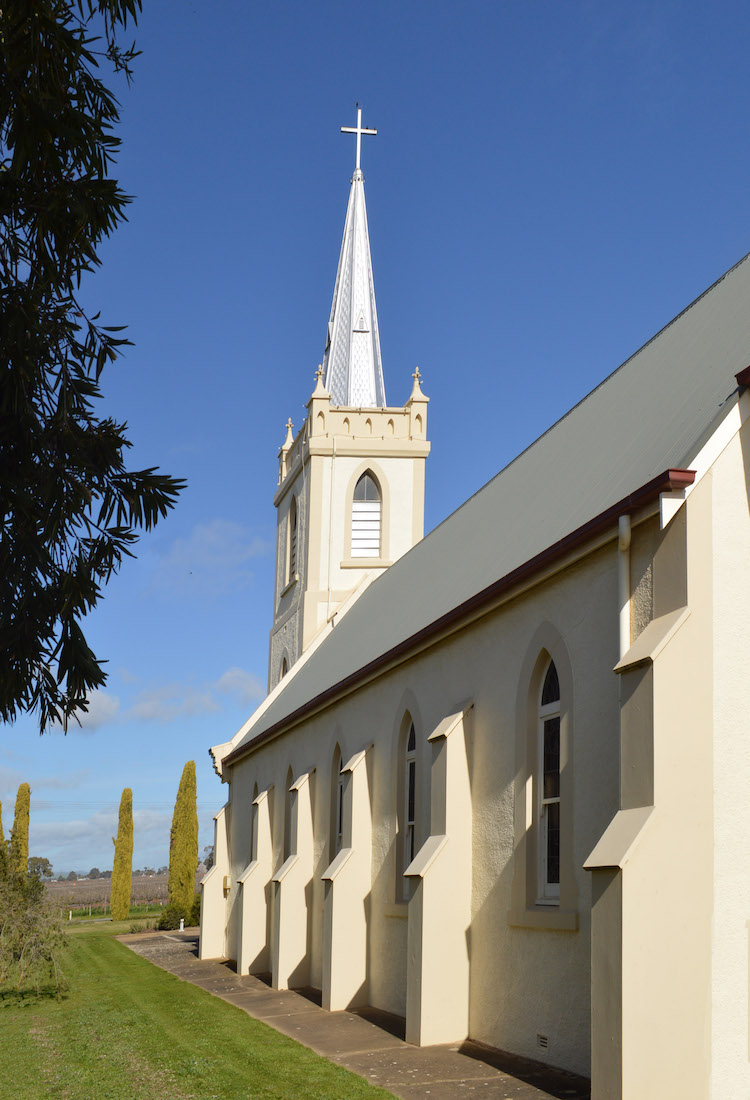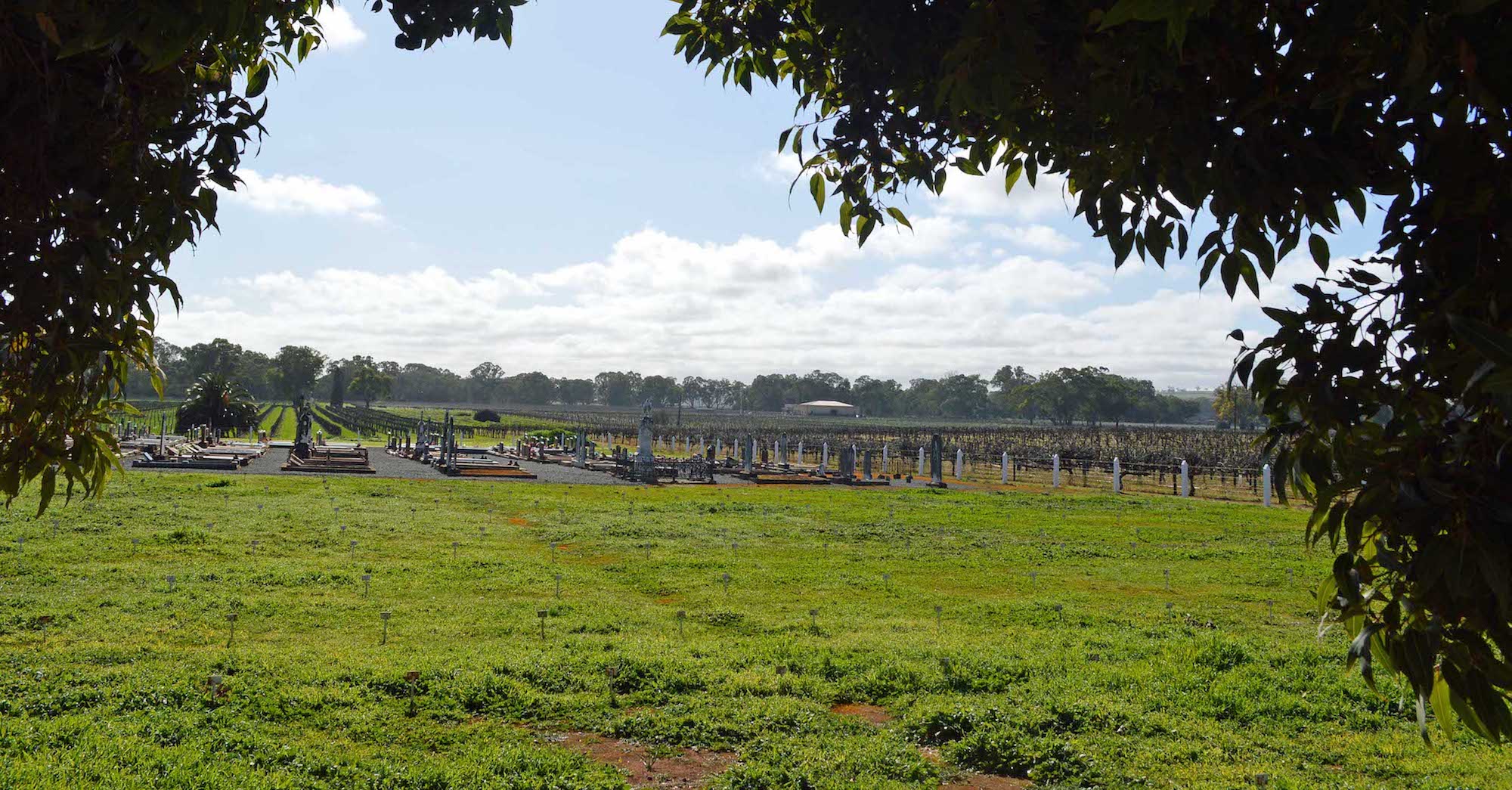
Driving north up Light Pass Road we arrive at the little settlement of Light Pass and the cul-de-sac called Immanuel Way. The Church tower and spire are visible over the surrounding vineyards. A smart sign tells us we have arrived; on the back of the sign are symbols of the Eucharist
2. CROSS AND SIGN

Closer to the Church is a rough wooden cross (‘an old rugged Cross’), and a little further on a sign proclaiming that we are special to God.
3. APPROACHING THE CHURCH
We draw close to the Church. Like other Lutheran churches in the Barossa, Immanuel Church has smart clean lines, and a tower which proudly bears the Cross of Christ. The Church has a roughly north-west axis geographgically. We shall find it helpful to use liturgical directions on this site, with the sanctuary facing East (with a capital letter).
4. NORTHWEST VIEW
The North side ofthe Church is shielded by shrubs. We notice that there are two plaques on the tower: one facing us on the North wall, and the other facing outwards above the West doors.
5. TOWER PLAQUES
The side plaque (in German) reads: ‘To our God was this stone laid, on 3rd August 1930, by Pastor F.W. Matschoss, 1 Peter 2:6.’ The front plaque is older and rather more weathered. It reads: ‘Ev. Luth. Immanuel Church. 1886. Bell tower built 1930.’
6. FRONT ENTRY
This is the front Western view of the Church, as seen by the congregation entering Sunday by Sunday.
7. SOUTH WALL
This side wall of the Church has five windows, separated by the buttresses supporting the wall. At right we glimpse the cemetery behind the Church.
8. LOOKING BACK
From here we can look back to the tower with its neat shining silver spire. The Church is set amongst large vineyards.
9. EASTERN VIEW
From the Eastern end we see the apse with its three unevenly placed windows, and the attached vestry to one side. The building to the right is the Church hall and administration centre.
10. NORTHEAST VIEW
We continue our circuit to this Northeast position. The vestry blends well with the body of the Church. There are just four windows along this side of the nave, because of the vestry.
11. VESTRY WALL
This rather uninspiring view of the vestry wall brings us to the end of our walk around the Church. On the gable is a cross which seems to be used by the Lutherans: a budded cross, often with a circular centre – the sun or perhaps the Lutheran rose.
12. CEMETERY
As with many of the Barossa Valley churches, there is a cemetery just at the back of the Church. Historically across the Valley, various groups of German settlers would live in communities, each with a church at the centre – the centre for life, and for death.
13. CEMETERY LISTING
This plaque lists the names of those buried in the Immanuel Cemetery. We note the deaths of many babies and young children: times were hard in the old days.
14. OLD CHURCH CROSS
By the cemetery plaque stands an old silver cross that used to adorn the top of the spire from 1930 to 1961. This cross was restored and placed here in 1996, at the time of the 150th Celebration.
15. VESTRY WINDOW
We enter the vestry. There are three identical windows here. This is the West facing window. Each window features a budded cross with a fleur-de-lys above.
16. WEST AND NORTH VESTRY WALLS
The walls of the vestry are lined with photographs of past pastors who have served at Immanuel Church.
17. EAST VESTRY
I am reminded of how the old Israelites remembered their past, and the ways God had blessed them in earlier times. We now leave the vestry and move into the Church itself.
18. NAVE
A striking feature of this Church is the Gothic arch framing the sanctuary and the way the nave ceiling has been shaped to follow the same lines.
19. A CLOSER VIEW
We notice the banners, the pulpit and lectern, and the central font, as well as the altar area. The rolled up screen at right indicates the use of some more modern technology.
20. NORTH WALL
We see here the balcony at left, the four Gothic windows, and a banner at right. At centre is a symbol of the Holy Spirit: a dove and a red flame.



















